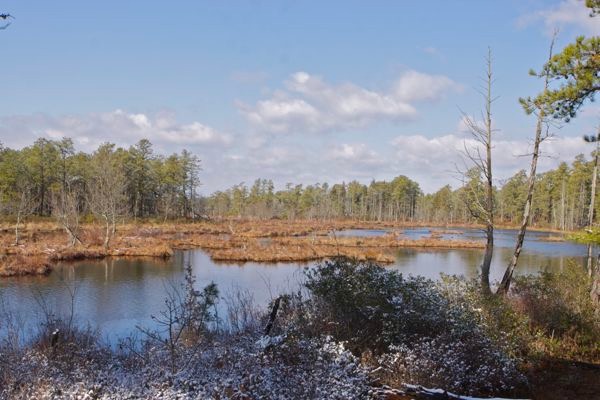Loopholes Allow DEP To Destroy Wetlands, Streams, Vernal Pools, & T&E Habitat
Developer Would Face Huge Fines & Possible Jail Time For A Fraction Of That Destruction
DEP Ignores Their Own Science And regulatory Standards And Protections
In a highly irresponsible show of rank hypocrisy, the Murphy DEP’s controversial Pinelands “Forest Management” (logging) plan fails to meet the same DEP protective regulatory standards that DEP enforces on the citizens and developers of the State.
The DEP simply just ignored all those requirements that they impose on others.
DEP is exploiting their own regulatory loopholes (and weak and obsolete 30 year old science from DEP’s 1995 Wetlands Forestry Management BMP Manual) to destroy exceptional natural resources that any developer would face $50,000 per day enforcement fines for destroying (and possible criminal prosecution for knowing violations).
And DEP is doing all that in the most pristine and exceptional ecosystem of the State. Let me explain.
We can all agree that the NJ Pinelands are an exceptional ecological resource.
That’s why they were protected by Congress and the NJ Legislature, and recognized by the UN as a World Biosphere Reserve.
That’s why the Pinelands Commission was created to protect and preserve them and why the Pinelands Preservation Alliance was formed to promote and advocate for their protection and watchdog government management of those exceptional natural resources.
It’s why the NJ Conservation Foundation acquires thousands of acres of exceptional value land to preserve and protect Pinelands ecosystems and water resources.
Across the State, under a series of federal and State environmental laws, in far less pristine and ecologically valuable places than the Pinelands, the NJ DEP has a series of land use and water resource regulatory standards to protect “exceptional value” natural resources.
The DEP’s overall protective framework for protection of natural resource is “avoidance, minimization, and mitigation” of any impacts to those resources. Any adverse impacts must be justified by the lack of any less damaging alternatives.
This framework is bolstered by minimum width buffers and requirements to delineate, inventory, assess, and monitor natural resources and environmental impacts, among many other technical requirements.
Here are just the buffer requirements and protective standards from other DEP regulations that their Forest management (logging) plan fails to meet:
- Exceptional Ecological Value Streams
Exceptional value waters are defined and classified in DEP’s surface water quality standards as FW1 and “Category One waters” (C1). C1 waters are protected by strict antigdegredation policy (no degradation and no change to existing water quality, respectively) and 300 foot buffers in other DEP regulations (e.g. stormwater, stream encroachment, WQMP, and Highlands).
- Exceptional Highlands waters
7:38-3.6 Highlands open waters
(a) There shall be a 300-foot buffer adjacent to Highlands open waters in which no disturbance is permitted,
- Exceptional Value Freshwater Wetlands
Under the DEP wetlands rules, drainage to exceptional water quality streams (FW 1 & C1) and the presence of habitat for threatened or endangered species triggers exceptional value wetlands classification and at least 150 foot buffers (7:7A-3.2 Classification of freshwater wetlands by resource value
standard width of a transition area adjacent to a freshwater wetland of exceptional resource value shall be 150 feet. (NJAC 7:7A-3.3 (d) 1.)
- Habitat For Threatened and Endangered Species
The Department shall not issue a HPAA unless it determines that the proposed activity will not jeopardize the continued existence of, or result in the likelihood of the destruction or adverse modification of habitat for, any rare, threatened or endangered species of animal or plant.
- Vernal Pools
(d) The Department shall not issue an HPAA unless the proposed activity would result in the minimum practicable degradation to a unique or irreplaceable land type or existing scenic attributes on the site or within the immediate area of the proposed project
In contrast to having to meet all those standards and requirements, the DEP forestry plan would slaughter the forest by cutting 90-96% of understory trees and vegetation (over 1,300 acres, 2.4 million trees cut), disturbing and compacting soils and forest duff, greatly decreasing canopy cover, and applying toxic herbicides to kill the invasive plants that grow in disturbed soils and sunlight on the forest floor from destruction of the canopy
That would destroy (never mind jeopardize!) habitat, wetlands functions, and pollute and lower water quality, while the buffers in the DEP Pinelands Forestry Plan are just 80 – 100 feet for those same exceptional value resources.
The DEP conducted no 1) demonstration of need, 2) no alternatives analysis, 3) no avoidance analysis, 4) no mitigation, 5) no comprehensive natural resource inventory, 6) no regulatory delineations, 7) no environmental impact analysis, and 9) there is no followup monitoring of ecological and water quality impacts.
And there will be no DEP compliance monitoring, inspection, and enforcement of the Pinelands Commission’s approval of this sham.
And to add absurdity to the DEP’s hypocrisy, the DEP “Forest Management” plan was SUPPORTED by the Pinelands Preservation Alliance and the NJ Conservation Foundation (who both called a 13 mile long, 50 foot wide clearcut, bisected by a road, a “MEADOW”).
I am beyond words.
This DEP plan can not become the model for wildfire management, for forestry management, or for carbon storage and sequestration. It must be repudiated and stopped
Please call Gov. Murphy at 609-292-6000 and demand that he stop this insanity by vetoing the minutes of the Pinelands Commission. The Gov. must do this before the end of November.


Pingback: WolfeNotes.com » ORWELL: Conservationists Conduct Tour To Promote DEP Logging Of Pinelands Forests